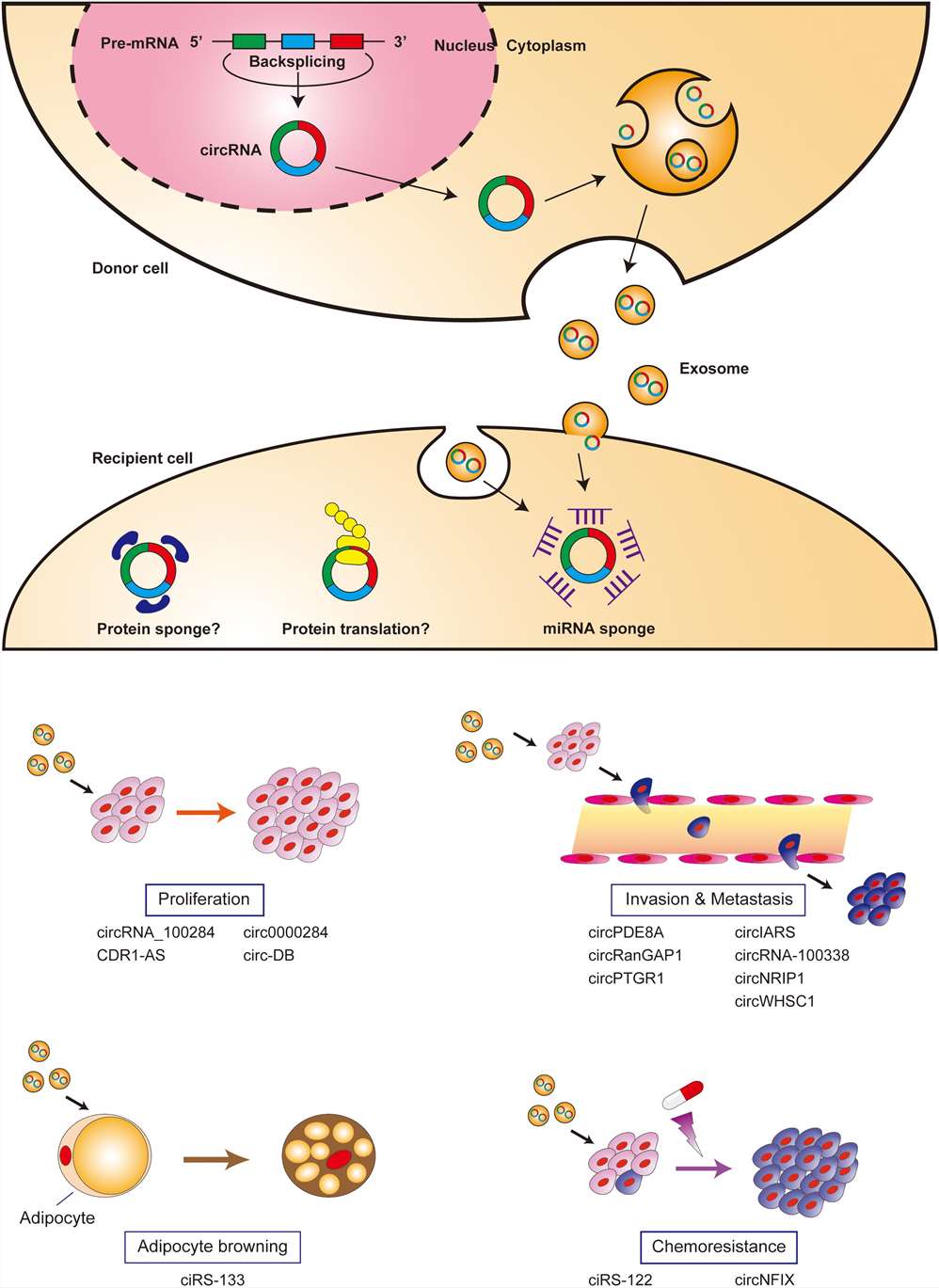Exosomes for circRNA Delivery
Online InquiryCircular RNAs (circRNAs) are a type of non-coding RNAs (ncRNAs) that are involved in post-transcriptional regulation. circRNAs are highly conserved and have a stable covalently closed continuous loop structure. CircRNAs naturally carried by exosomes have been widely used in cancer therapy, and their high delivery efficiency has greatly improved the therapeutic efficacy. Recent studies have shown that exogenous circular RNAs can act as templates for protein translation, allowing stable protein translation that bypasses cellular RNA sensors. Despite the possibility of immunogenicity, exosomal delivery of tumor-suppressing cyclic circRNAs may be a new cancer therapy.
circRNAs
circRNAs were originally thought to be intermediate products of intron lariats that have escaped degradation or by-products of aberrant splicing. With the development of detection technology and intensive research, it was found that circRNAs are molecules of ncRNAs consisting of hundreds or even thousands of nucleotides. These ncRNAs are formed by reverse splicing, mainly through noose structures or intron complementary pairing. Many tissues and cells express circRNAs, and the expression pattern of circRNAs varies depending on cell type and tissue as well as developmental stages. So far, there are more than 180,000 circRNAs are present in human transcriptomes, suggesting that circRNAs have unique regulatory mechanisms and cellular functions. Moreover, aberrantly expressed circRNAs have been demonstrated to be associated with carcinogenesis, where circRNAs serve as microRNA (miRNA) sponges, protein scaffolds, or new templates for protein translation.
Features of exosomal circRNAs
- Enriched and stable in exosomes
- Promote cellular proliferation
- Contribute to tumor invasion and metastasis
- Associated with chemotherapy resistance
- Not only involved in intercellular communication between tumor cells, but also promote cancer cachexia.
 Fig. 1 Biological functions of exosomal circRNAs. (Seimiya, Takahiro, et al., 2022)
Fig. 1 Biological functions of exosomal circRNAs. (Seimiya, Takahiro, et al., 2022)
Delivery of therapeutic circRNA
circRNA is one of the emerging nucleic acid drugs. The special loop structure of circRNA not only prevents being degraded and improves circRNA expression and expression time, but also allows repeated administration. However, there are some challenges with the exosome-based delivery of exogenous circRNAs. On one hand, circRNAs have low circular efficiency. On the other hand, macromolecular circRNAs are difficult to load into the exosomes. To address these issues, the researchers have built relevant lentiviral vectors to properly and efficiently cyclize circRNAs and transfect them into target cells and load them into exosomes. More in-depth studies are needed to provide references for the application of exosome-mediated delivery of circRNA in disease.
Creative Proteomics is committed to providing innovative solutions to power your biological research. We are proud to offer a range of exosome research and analysis services. In addition to scalable upstream production and isolation of exosomes, we offer downstream processing for efficient exosome characterization and labeling to provide our customers with high quality exosomes. Notably, our services include the following services but are not limited to them. Our comprehensive, customized, and flexible services can greatly promote the application of exosomes as carriers for circRNA delivery.
| Exosome analysis services | |
|---|---|
| Exosome isolation and purification | Sucrose gradient centrifugation |
| Polymer-based exosome enrichment method | |
| Immunomagnetic bead method | |
| Size exclusion chromatography method | |
| Exosome identification | Nanoparticle tracking analysis (NTA) |
| Electron microscopy analysis | |
| Western blot | |
| Exosome marker assay | Isolation and enrichment of exosomal CD9, CD63, CD81, TSG101, HSP70 proteins |
| Exosome surface protein identification and quantitative analysis | |
| Exosome engineering | Exosome labeling and tracking |
| Cargo loading | |
| Engineered exosome production | |
| Cargo loading assessment | |
| Exosomes labeling and tracking | Exosome fluorescent labeling |
| Fluorescence exosome purification | |
| Fluorescent exosome concentration labeling | |
| Exosome multiomics analysis | Exosome proteomics analysis: Exosome protein profile identification Exosome protein composition analysis Exosome protein expression level analysis Exosome protein differential expression analysis |
| Exosome metabolomics analysis: Exosome differential metabolite screening Qualitative and quantitative analysis of target metabolites/metabolic pathways | |
| Exosome lipidomics analysis: Exosome lipid composition and level analysis Differential expression analysis of exosomal lipid molecules Qualitative and quantitative analysis of targeted lipid molecules | |
| Exosomal biogenesis and identification | Our capabilities will provide strong support for the study of exosome biogenesis and its identification. |
| Exosomal cargo and loading mechanism | Our services can greatly help the study of exosomal cargo and loading mechanism, facilitating the diagnostic and therapeutic applications of exosomes. |
| Exosome function research | In vitro analysis of the function of exosomes In vivo analysis of the function of exosomes |
References
- Zhang, Ying, et al. "Recent advances in exosome-mediated nucleic acid delivery for cancer therapy." Journal of Nanobiotechnology 20.1 (2022): 1-29.
- Seimiya, Takahiro, et al. "Emerging roles of exosomal circular RNAs in cancer." Frontiers in cell and developmental biology 8 (2020): 568366.
* For Research Use Only. Not for use in diagnostic procedures.



